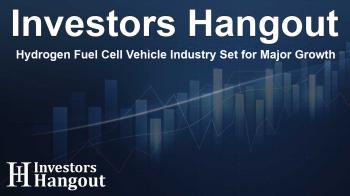Hydrogen Fuel Cell Vehicle Industry Set for Major Growth

Strong Growth in Hydrogen Fuel Cell Vehicles
The global hydrogen fuel cell vehicle market is undergoing a remarkable transformation, projected to soar from a valuation of $1.3 billion in recent years to an astonishing $46.4 billion before the end of the decade. This growth, representing a compound annual growth rate (CAGR) of 43.2%, highlights the surging interest and investment in hydrogen-powered technology.
Factors Driving Market Growth
Several key factors are contributing to this robust growth. Firstly, supportive government initiatives aimed at advancing hydrogen fuel cell technology are crucial. These initiatives often include financial incentives and subsidies for research and development, encouraging innovation and market penetration.
Moreover, there is a rising demand for vehicles that produce zero emissions. As concerns regarding climate change and air quality gain importance, consumers and manufacturers alike are gravitating towards sustainable alternatives, such as hydrogen fuel cell vehicles.
Additionally, advancements in commercial hydrogen fuel cell technology are bolstering market prospects. As manufacturers develop more specialized vehicles equipped with hydrogen fuel cells, there is a heightened opportunity for widespread adoption across various sectors, including passenger and heavy-duty vehicles.
Detailed Market Overview
Technology Analysis
Among the different technologies in hydrogen fuel cells, the proton exchange membrane (PEM) fuel cell emerged as a frontrunner, dominating the market share in recent assessments. Known for remarkable efficiency at varying load conditions, PEM fuel cells convert hydrogen and oxygen into electricity with minimal energy loss, making them ideal for automotive applications.
Vehicle Types and Market Segmentation
When broken down by vehicle type, passenger vehicles have captured the largest market share. This is largely due to their lower power requirements, allowing for easier integration of hydrogen fuel cell technology. In contrast, commercial vehicles face higher production costs and energy requirements, limiting their use of hydrogen fuel systems.
Range Dynamics in Fuel Cell Vehicles
Looking at operational ranges, vehicles capable of traveling between 251 and 500 miles dominate the segment. This range offers an appealing mix of practicality and efficiency, catering to a broader audience seeking reliable options for both daily commutes and longer road trips.
Regional Insights and Market Leaders
Asia-Pacific is currently leading the market in terms of revenue, propelled by industry giants such as Hyundai Motor Group and Toyota Motor Corporation, among others. Governmental support throughout this region notably aids the development and deployment of hydrogen fuel cell technology, creating a favorable ecosystem for growth.
Countries including Japan, South Korea, and China are at the forefront of this movement, offering various incentives aimed at bolstering the hydrogen fuel cell market. These strategic advantages position the Asia-Pacific region as a leader in the hydrogen vehicle industry.
Opportunities and Future Trends
As the market evolves, numerous opportunities arise from the technological advancements within the hydrogen fuel cell domain. The development of infrastructure, including hydrogen refueling stations, is vital. Efforts to improve hydrogen infrastructure and storage solutions will further enhance consumer adoption rates.
Moreover, as production capabilities expand and costs decrease, it is expected that electric vehicles will witness enhanced competition from hydrogen-powered options. This evolving landscape will pave the way for a diverse array of vehicle applications in the years to come.
Frequently Asked Questions
What is the current market size of the hydrogen fuel cell vehicle industry?
The hydrogen fuel cell vehicle market was valued at approximately $1.3 billion recently.
How fast is the hydrogen fuel cell vehicle market expected to grow?
It is anticipated to grow at a CAGR of 43.2%, reaching $46.4 billion by 2033.
What are the primary technologies in hydrogen fuel cells?
The main technologies include Proton Exchange Membrane and Phosphoric Acid Fuel Cells.
Which segment holds the largest market share?
The passenger vehicle segment currently holds the largest market share due to its affordability and efficiency.
What regions are leading in hydrogen fuel cell market revenue?
The Asia-Pacific region is the leading market, thanks to major industry players and strong governmental support.
About The Author
Contact Ryan Hughes privately here. Or send an email with ATTN: Ryan Hughes as the subject to contact@investorshangout.com.
About Investors Hangout
Investors Hangout is a leading online stock forum for financial discussion and learning, offering a wide range of free tools and resources. It draws in traders of all levels, who exchange market knowledge, investigate trading tactics, and keep an eye on industry developments in real time. Featuring financial articles, stock message boards, quotes, charts, company profiles, and live news updates. Through cooperative learning and a wealth of informational resources, it helps users from novices creating their first portfolios to experts honing their techniques. Join Investors Hangout today: https://investorshangout.com/
The content of this article is based on factual, publicly available information and does not represent legal, financial, or investment advice. Investors Hangout does not offer financial advice, and the author is not a licensed financial advisor. Consult a qualified advisor before making any financial or investment decisions based on this article. This article should not be considered advice to purchase, sell, or hold any securities or other investments. If any of the material provided here is inaccurate, please contact us for corrections.

